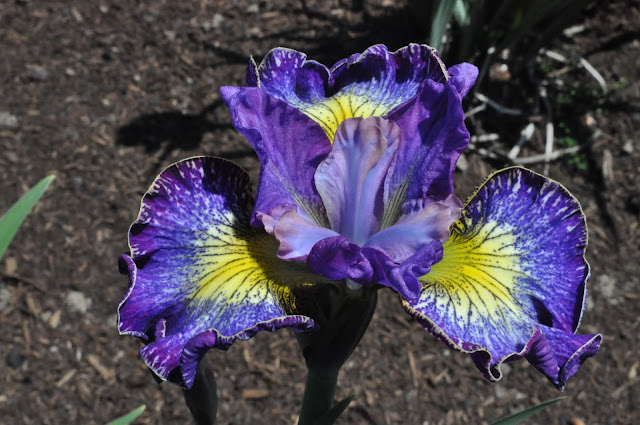By Bryce Williamson
While my
first blog on this amazing garden focused on Siberian irises, this time I want to highlight some of the other beardless irises growing in the garden that Chad Harris grows and, in two cases, hybridizes.
Last year, on my first visit to Mt. Pleasant Iris Farms, I drove up Highway 14 and onto Marble Road to the manicured garden, where I parked in the shade by the barn. Immediately I was drawn to one of the water features of the garden— a lovely pond with naturalized irises. A spring on the north hillside provides the gravity feed to run sprinklers.

Little did I know at that moment that almost 25 years of hard work has gone into this paradise.
Chad is careful not to plant any water irises that are fertile and might release seeds that would get into the Columbia River Basin ecosystem.

Chad has spent the last 15 years working with Iris laevigata, a native to North East Asia, Russia, and Japan. As the Mt. Pleasant catalogue notes, “A true water iris, Iris laevigata will look its best growing in shallow water or a large pot with a deep reservoir filled with water. It can also thrive in a moist to wet setting such as a rain garden."
“Iris Laevigata will grow from 24 to 36 inches tall with 4 to 6 inch flowers." To date, Chad has introduced the two hybrids pictured below:
 |
| 'Lakeland Ghost' |
 |
| 'Blue Rivulets' photo by Chad Harris |
Recently, Chad has also been growing "Pseudata" seedlings. These are, to quote from the catalogue, “a cross between plants with iris pseudacorus backgrounds and iris ensata (Japanese, Hanashobu). The iris world is very fortunate that Hiroshi Shimizu shared many years of his work; finding a good pod parent ('Gubijin') so all hybridizers could explore the possibilities that this cross may bring to the garden."
 |
| Harris pseudata seedling in a clump |
 |
| Harris 08SPCX D photo by Chad Harris |
 |
| Harris HPIM9403 photo by Chad Harris |
 |
| Harris 08SPCX D photo by Chad Harris |
 |
| Harris 08SPCX F photo by Chad Harris |
During the National Convention of
The American Iris Society in which this garden was part of the tour, one other interspecies hybrid attracted much attention. In a huge, husky clump, Jill Copeland’s
'Do the Math' was impressive.

A surprise in the garden was Phillip Ramare's PC-1. Usually Pacific Coast Natives bloom early, but this nicely colored seedling was still in good bloom.
Chad Harris's introductions can be found at two sources:
http://www.mtpleasantiris.com and
http://aitken-garden.goodsie.com. Both Mt. Pleasant Iris Farms and Aitken’s Salmon Creek also carry a wide range of other types of beardless irises.
More on Mt. Pleasant Iris Farms to come!
Please respect the copyright on these images by Bryce Williamson and Chad Harris.




















































